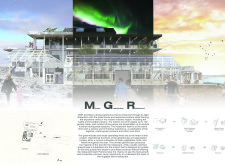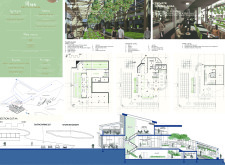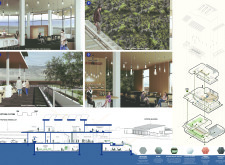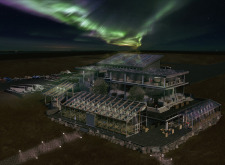5 key facts about this project
At its core, the design of the MGR Greenhouse Restaurant represents the principles of sustainability, local sourcing, and culinary innovation. The architecture reflects a commitment to these values through the incorporation of greenhouses, which allow for year-round cultivation of vegetables and herbs that directly feed into the restaurant's menu. This functional integration of agriculture into dining emphasizes a farm-to-table approach, enabling guests to appreciate the origin of their food in a tangible way.
The essential components of the MGR Greenhouse Restaurant can be broken down into its distinctive levels and various spaces. The ground level features a spacious public greenhouse, designed to be visually open and inviting. Here, guests can observe the growth of fresh produce, bridging the gap between the farm environment and the dining experience. Adjacent to the greenhouse are communal dining areas, fostering social interaction and community gatherings. The upper levels provide panoramic views of the dramatic landscape, designed to heighten the experience of dining in such a unique location.
Material selection within the project plays a vital role in expressing its connection to the environment. Textured concrete is employed, echoing the qualities of the local volcanic rock, while steel is used to provide structural stability alongside an aesthetic appeal. Large glass storefronts maximize natural light, creating an interior ambiance that enhances the overall atmosphere of the restaurant while ensuring guests feel connected to the surrounding vistas. Furthermore, the use of sustainable timber cladding on the building's exterior brings warmth to the architectural design. Unique elements, such as lava moss accent walls, further enhance the interior, reinforcing the relationship between the building and its natural context.
Spatial planning within the restaurant is meticulously organized to optimize functionality while ensuring an engaging flow for guests. Public and private dining spaces are thoughtfully arranged; the larger communal dining area accommodates diverse group sizes while the more intimate private dining facilities cater to those seeking a personal experience. There is also a multipurpose hall designed for various functions, showcasing the versatility of the space.
The MGR Greenhouse Restaurant goes beyond mere architectural design; it embodies a philosophy of responsible consumption, education, and connection to the land. Unique design approaches, such as integrating on-site agricultural practices and creating spaces that encourage exploration and understanding of food production, set this project apart. Each element contributes to an overarching narrative that invites diners to engage with the ingredients in their meals, ultimately enriching the cultural context of the dining experience.
As an architectural endeavor, the MGR Greenhouse Restaurant serves as a model of how thoughtful design can harmonize with the natural environment while enhancing community and sustainability. To gain a deeper understanding of the architectural ideas and detailed design elements, including architectural plans and sections, we encourage interested readers to explore the project further. The MGR Greenhouse Restaurant not only offers delicious locally sourced meals but also illustrates the significant role architecture can play in promoting sustainable practices and fostering community connections.


























